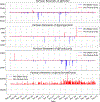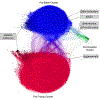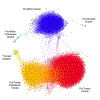Followback Clusters, Satellite Audiences, and Bridge Nodes: Coengagement Networks for the 2020 US Election
- PMID: 38655460
- PMCID: PMC11037522
- DOI: 10.1609/icwsm.v17i1.22126
Followback Clusters, Satellite Audiences, and Bridge Nodes: Coengagement Networks for the 2020 US Election
Abstract
The 2020 United States (US) presidential election was - and has continued to be - the focus of pervasive and persistent mis- and disinformation spreading through our media ecosystems, including social media. This event has driven the collection and analysis of large, directed social network datasets, but such datasets can resist intuitive understanding. In such large datasets, the overwhelming number of nodes and edges present in typical representations create visual artifacts, such as densely overlapping edges and tightly-packed formations of low-degree nodes, which obscure many features of more practical interest. We apply a method, coengagement transformations, to convert such networks of social data into tractable images. Intuitively, this approach allows for parameterized network visualizations that make shared audiences of engaged viewers salient to viewers. Using the interpretative capabilities of this method, we perform an extensive case study of the 2020 United States presidential election on Twitter, contributing an empirical analysis of coengagement. By creating and contrasting different networks at different parameter sets, we define and characterize several structures in this discourse network, including bridging accounts, satellite audiences, and followback communities. We discuss the importance and implications of these empirical network features in this context. In addition, we release open-source code for creating coengagement networks from Twitter and other structured interaction data.
Figures









References
-
- Abilov A; Hua Y; Matatov H; Amir O; and Naaman M 2021. VoterFraud2020: a Multi-modal Dataset of Election Fraud Claims on Twitter. arXiv:2101.08210 [cs].
-
- Arif A; Stewart LG; and Starbird K 2018. Acting the Part: Examining Information Operations Within #Black-LivesMatter Discourse. Proceedings of the ACM on Human-Computer Interaction, 2(CSCW): 1–27.
-
- Bastian M; Heymann S; and Jacomy M 2009. Gephi: an open source software for exploring and manipulating networks. In Third international AAAI conference on weblogs and social media.
-
- Benkler Y; Tilton C; Etling B; Roberts H; Clark J; Faris R; Kaiser J; and Schmitt C 2020. Mail-In Voter Fraud: Anatomy of a Disinformation Campaign. SSRN Scholarly Paper ID 3703701, Social Science Research Network, Rochester, NY.
-
- Brandes U 1999. Layout of graph visualizations. PhD diss., University of Konstanz.
Grants and funding
LinkOut - more resources
Full Text Sources
